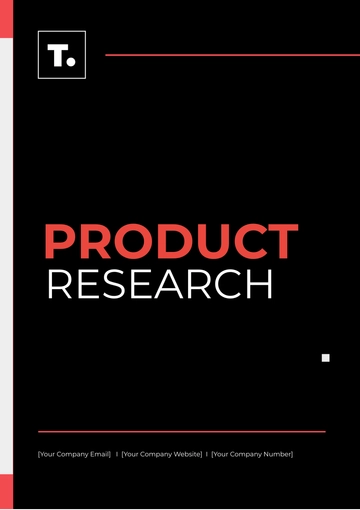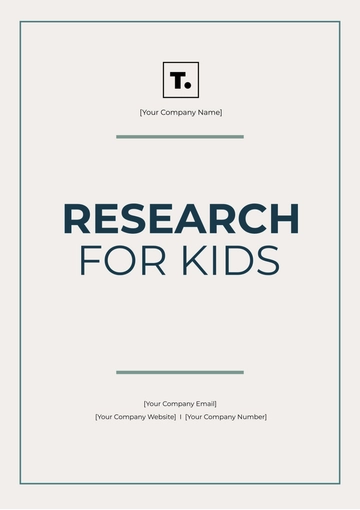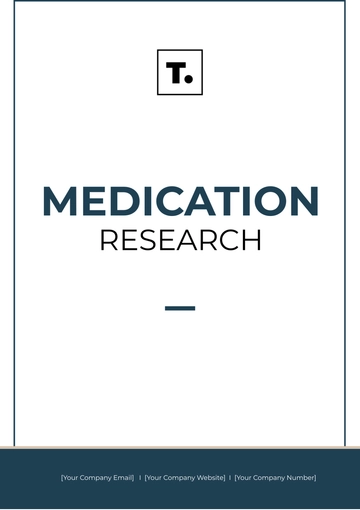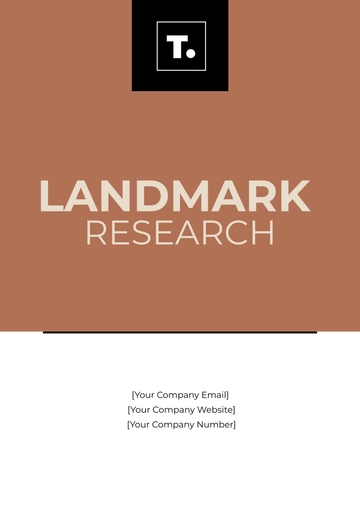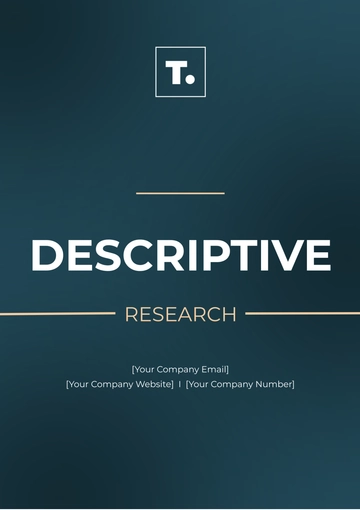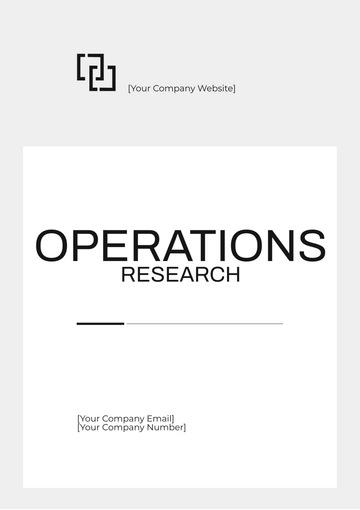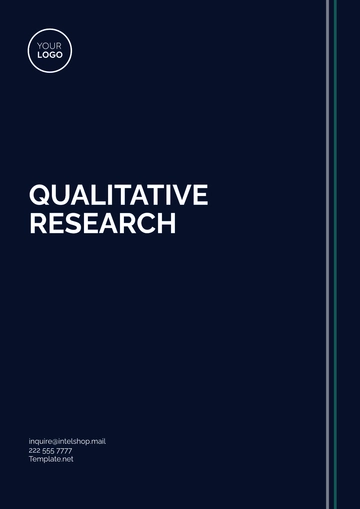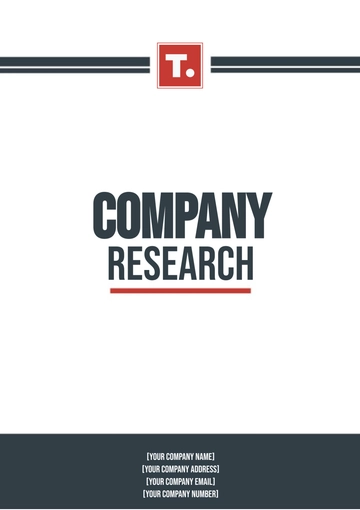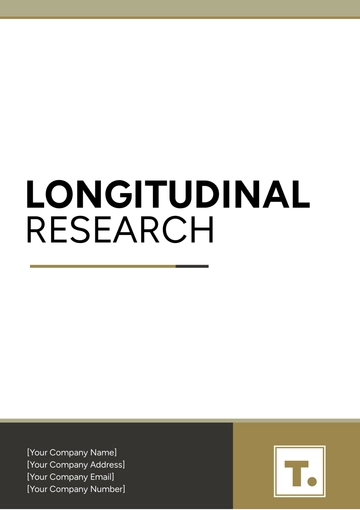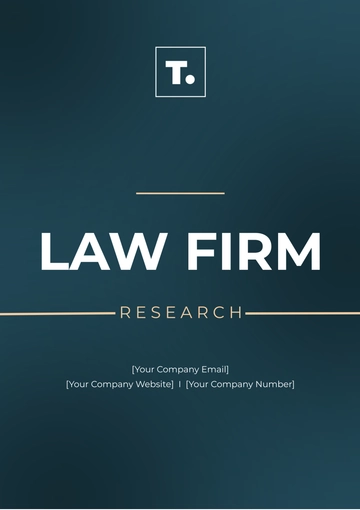Free Financial Compliance Research
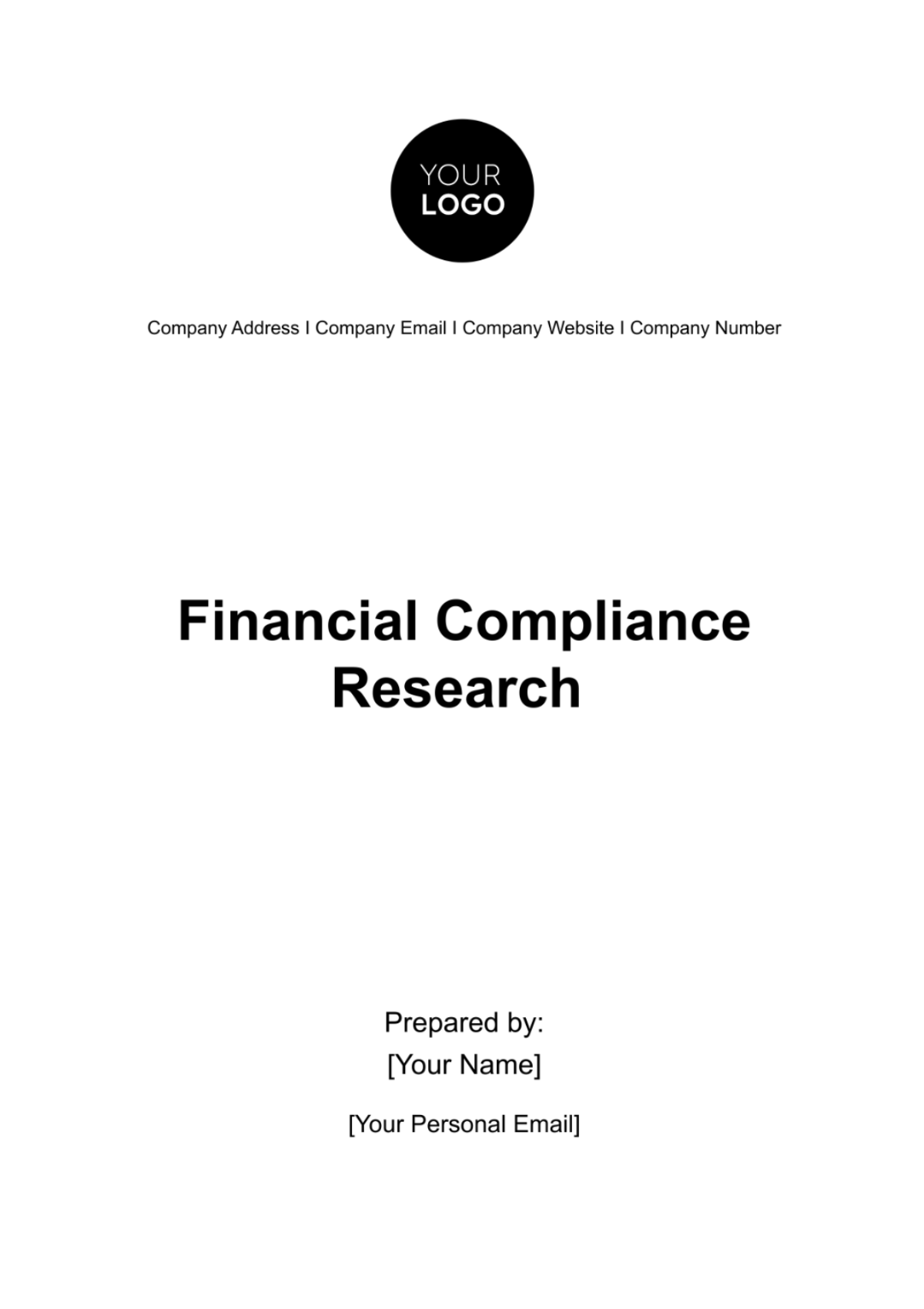
1. Introduction
1.1 Purpose
The primary objective of this document is to provide an exhaustive and detailed analysis of the financial compliance requirements that [Your Company Name] must adhere to. This involves a thorough review and understanding of the various laws, regulations, and standards that significantly influence the financial operations of the company. In a rapidly evolving financial landscape, it's crucial for [Your Company Name] to stay abreast of these requirements to ensure legal and ethical business practices.
This document serves multiple purposes:
Guidance Tool: It acts as a guide for the company's management and financial teams to understand and implement compliance-related practices effectively.
Risk Management: By identifying and understanding the compliance requirements, the company can proactively manage and mitigate potential financial risks.
Regulatory Update: It provides a consolidated view of the latest laws and regulations, aiding in keeping the company updated with the ever-changing financial regulatory environment.
Training Resource: The document can be used as a training material for new employees or for ongoing training programs, ensuring that all staff members are aware of compliance requirements.
1.2 Scope
The scope of this document encompasses several key areas essential for maintaining financial compliance:
Tax Laws: This includes federal and state tax regulations, tax filings, deductions, credits, and compliance with tax authorities. International tax laws are also covered for global operations, emphasizing transfer pricing and tax treaties.
Financial Reporting Standards: The document details the standards for financial reporting, including the Generally Accepted Accounting Principles (GAAP) in the United States and the International Financial Reporting Standards (IFRS) for international operations.
Anti-Money Laundering (AML) Protocols: This section provides a comprehensive overview of AML laws and regulations, such as the Bank Secrecy Act and the USA PATRIOT Act. It also outlines the procedures for customer due diligence and transaction monitoring systems.
Data Protection Regulations: With increasing focus on data security, this part of the document addresses the compliance with data protection laws like the GDPR and CCPA, emphasizing the importance of securing financial data.
1.3 Document Maintenance
In recognition of the dynamic nature of financial regulations and standards, this document is designed to be a living document, subject to regular review and updates. The following points outline the maintenance strategy:
Annual Review: The document will undergo a comprehensive review every year to incorporate any changes in laws, regulations, and industry best practices.
Update Mechanism: Any significant regulatory changes will trigger an immediate review and update of the relevant sections, ensuring the document remains current and relevant.
Version Control: Each update will be documented with version control to track changes over time, providing a historical view of the evolving compliance landscape.
Stakeholder Feedback: Feedback from key stakeholders and compliance officers will be sought during each review cycle to ensure the document's accuracy and practicality.
1.4 Contact Information
The following contact information is provided for any queries or further information related to this document:
Company: [Your Company Name]
Address: [Your Company Address]
Email: [Your Company Email]
Phone: [Your Company Phone Number]
Website: [Your Company Website]
Prepared by: [Your Name], [Your Title]
Date: [Month Day Year]
This contact information serves as a direct line for communication regarding any aspect of this document or the compliance practices of [Your Company Name]. It ensures transparency and facilitates easy access to the relevant personnel responsible for maintaining financial compliance within the company.
2. Compliance Areas
When it comes to financial compliance, there are several critical areas that [Your Company Name] must diligently manage. This chapter provides an overview of these key compliance areas, each vital for maintaining the company's legal and ethical standing in its financial dealings.
2.1 Tax Compliance
Federal Tax Laws
The federal tax obligations of [Your Company Name] encompass various aspects, primarily corporate income tax and employment taxes. Corporate income tax involves the taxation of the company's profits, while employment taxes relate to obligations for employee compensation, including Social Security and Medicare taxes. Understanding and complying with these laws are fundamental to the company's financial health.
State Tax Laws
Each state in the United States may have unique tax regulations that affect [Your Company Name]. These can include state income taxes, sales taxes, and other business-related levies. The company must ensure compliance with the tax laws of each state in which it operates to avoid penalties and legal issues.
International Tax Compliance
For [Your Company Name]'s operations that cross international borders, compliance with international tax laws is crucial. This includes adhering to transfer pricing regulations, which dictate how transactions between company divisions in different countries are priced, and understanding tax treaties that might affect the business.
2.2 Financial Reporting Standards
GAAP (Generally Accepted Accounting Principles)
GAAP represents the cornerstone of financial reporting in the United States. These principles provide a framework for the preparation of financial statements, ensuring consistency, transparency, and comparability across different companies. [Your Company Name] must adhere to these principles in its financial reporting practices.
IFRS (International Financial Reporting Standards)
For [Your Company Name]'s international operations, compliance with IFRS is essential. These standards, which differ in some respects from GAAP, provide guidelines for financial reporting on an international scale, facilitating the comparison of financial statements across different countries.
2.3 Anti-Money Laundering (AML) Protocols
AML Laws and Regulations
The company must adhere to key laws and regulations like the Bank Secrecy Act (BSA) and the USA PATRIOT Act, which are designed to combat money laundering and terrorism financing. Compliance with these regulations includes implementing appropriate systems and controls within the company.
Customer Due Diligence
This involves verifying the identity of clients and assessing the associated risks in doing business with them. It is a crucial step in preventing the company from being used as a vehicle for money laundering.
Transaction Monitoring
[Your Company Name] must have systems in place for monitoring and reporting suspicious transactions. This not only involves tracking large or irregular transactions but also understanding the typical transaction patterns of its clients to identify anomalies.
2.4 Data Protection and Privacy
Data Protection Laws
With the global emphasis on data security, compliance with regulations like the GDPR (EU) and CCPA (California) is imperative. These laws govern the handling and protection of personal financial data, imposing stringent requirements on businesses to safeguard consumer information.
Data Security Measures
To comply with these data protection laws, [Your Company Name] must implement and maintain robust data security measures. This includes securing financial data against unauthorized access, data breaches, and other cyber threats. Regular audits, employee training, and the adoption of advanced security technologies are key components of these measures.
Each of these compliance areas requires continuous attention and periodic reassessment to ensure that [Your Company Name] remains in line with current laws and best practices.
3. Compliance Strategies and Action Plan
To ensure adherence to financial compliance regulations, [Your Company Name] has developed a comprehensive action plan. This plan is designed to proactively identify, assess, and mitigate compliance risks while ensuring continuous education and monitoring of compliance-related activities.
3.1 Risk Assessment
Methodology: The methodology for identifying and assessing compliance risks involves a systematic approach, including regular reviews of financial operations, analysis of regulatory changes, and consultations with legal and compliance experts. This approach is designed to be dynamic, adapting to new risks as they arise.
Risk Matrix:
Risk Category | Livelihood | Impact | Mitigation Strategy |
|---|---|---|---|
Tax Evasion | Low | High | Regular audits, employee training, and updated tax software |
Non-Compliance with AML | Medium | High | Enhanced due diligence procedures, ongoing staff training, and investment in AML software |
Data Breach | Medium | High | Implementation of robust cybersecurity measures, regular IT audits, and employee cybersecurity training |
Inaccurate Financial Reporting | Low | High | Frequent internal reviews, external audits, and financial control systems |
3.2 Compliance Training
Training Programs: The employee training programs at [Your Company Name] encompass a range of financial compliance topics. These include tax law compliance, anti-money laundering procedures, data protection and privacy laws, and ethical financial practices. The training is designed to be comprehensive and accessible, ensuring all employees understand their roles in maintaining compliance.
Training Schedule: The training schedule is structured to be conducted annually, with semi-annual refresher courses. Additional training sessions are scheduled whenever there is a significant change in compliance laws or regulations.
3.3 Auditing and Monitoring
Internal Audits: Internal audits are scheduled quarterly to assess and ensure compliance with financial laws and regulations. These audits are comprehensive, covering all aspects of financial operations, and are conducted by an independent internal audit team.
External Audits: External audits are conducted annually by a third-party firm. These audits provide an additional layer of scrutiny and help identify areas that might need improvement. They also serve to validate the company’s compliance status with external stakeholders.
Continuous Monitoring: [Your Company Name] employs continuous monitoring systems to ensure ongoing compliance. These systems include automated software for tracking financial transactions, regular checks for adherence to data protection protocols, and continuous updating of compliance databases. This approach ensures that any potential compliance issues are identified and addressed promptly.
4. Reporting and Documentation
The integrity and transparency of [Your Company Name]'s financial operations are largely contingent on effective reporting and meticulous record-keeping. This chapter outlines the company's approach to compliance reports and the management of financial records.
4.1 Compliance Reports
Frequency: To maintain a consistent and up-to-date overview of compliance status, [Your Company Name] produces compliance reports on a varied schedule:
Monthly Reports: These focus primarily on short-term compliance metrics, such as recent changes in regulations, immediate compliance issues, and preliminary financial data.
Quarterly Reports: These provide a more comprehensive view, including summaries of ongoing compliance initiatives, updates on long-term compliance projects, and detailed financial analyses.
Annual Reports: The most extensive, these reports include a year-end summary of the company’s financial status, an audit of annual compliance with all regulations, and an overview of the compliance plan for the coming year.
Content: The content of these compliance reports is carefully curated to provide insightful and actionable information:
Regulatory Updates: Information on any new or modified regulations that affect the company.
Compliance Status: Current status of the company in meeting various compliance requirements.
Risk Assessment Updates: Any changes in the risk matrix, including new risks identified and the status of risk mitigation strategies.
Audit Findings: Summaries of recent internal and external audit findings.
Training and Development: Updates on training programs and employee compliance awareness initiatives.
4.2 Record Keeping
Document Retention Policy: [Your Company Name] adheres to a strict document retention policy, ensuring that all financial records and compliance documents are preserved according to legal and regulatory requirements. This policy includes guidelines on the duration for which different types of documents should be retained, such as tax records, audit reports, compliance training materials, and transaction records.
Digital Storage: To facilitate efficient and secure storage of these documents, [Your Company Name] employs advanced digital storage solutions. These solutions offer:
Security: Robust encryption and security protocols to protect against unauthorized access and data breaches.
Accessibility: Easy retrieval of documents as needed, while maintaining strict access controls.
Backup Systems: Regular backups to prevent data loss and ensure data integrity.
Compliance with Digital Record-Keeping Laws: Ensuring that the digital storage solutions meet the requirements of various compliance laws regarding digital record keeping.
This comprehensive approach to reporting and documentation plays a crucial role in maintaining the financial integrity of [Your Company Name]. It not only ensures compliance with current regulations but also provides a robust framework for managing and responding to future regulatory changes.
5. Conclusion
This document serves as a pivotal guide for [Your Company Name] in navigating the complex landscape of financial compliance. By adhering to the outlined principles, strategies, and procedures, the company not only aligns itself with legal and regulatory standards but also fortifies its position against risks associated with non-compliance. This commitment to rigorous financial compliance underscores the company's dedication to ethical practices and operational excellence, ensuring sustainable growth and trust among stakeholders.
- 100% Customizable, free editor
- Access 1 Million+ Templates, photo’s & graphics
- Download or share as a template
- Click and replace photos, graphics, text, backgrounds
- Resize, crop, AI write & more
- Access advanced editor
Template.net's editable Financial Compliance Research Template is your comprehensive solution for ensuring regulatory adherence. This meticulously crafted document provides a user-friendly framework, simplifying complex compliance research processes. Tailor it to your specific needs and effortlessly maintain financial integrity using our AI editor tool for customization. Elevate your compliance efforts with this essential tool, designed to streamline your financial research endeavors.


